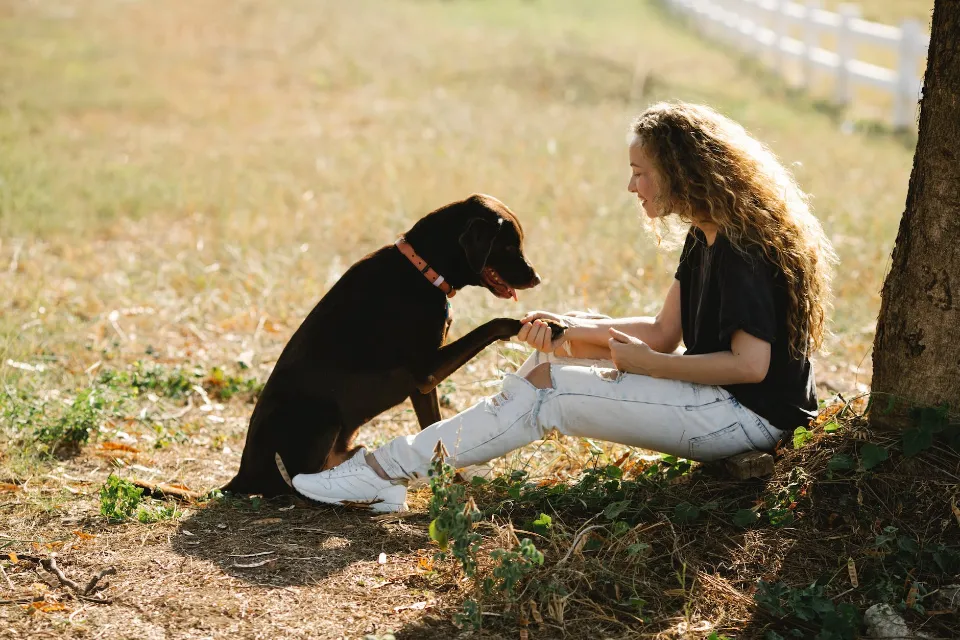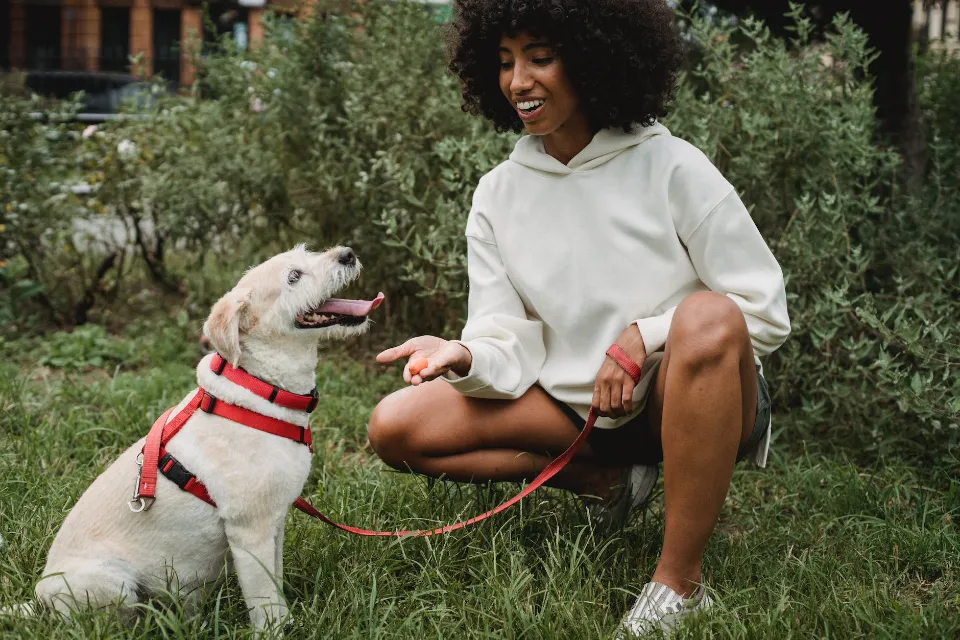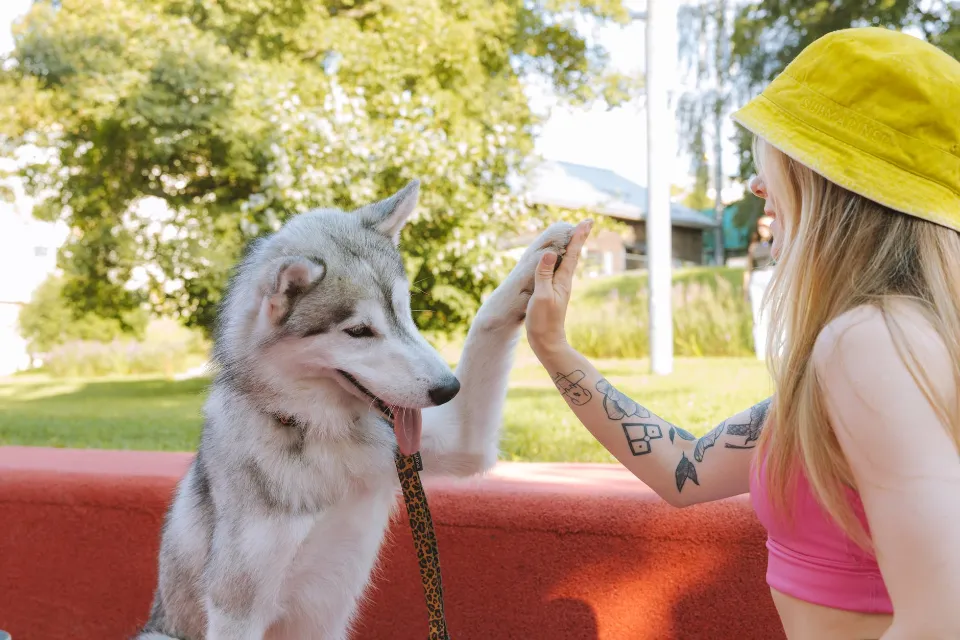Read on to find out how to train a deaf dog, whether your dog was born deaf or lost hearing due to old age or disease.
Deaf dogs can be taught to obey their owners despite the fact that they are unable to hear commands. Naturally, there are difficulties unique to this process that are not present in training a hearing dog. Although it takes a little more time and patience to train a deaf dog, most dog owners can manage it.
When training a deaf dog, one thing to keep in mind is to take extra care not to startle your pet. Any sudden movements, sensations, or touches can startle a dog who has hearing loss easily. Use these training methods and safety advice to train a deaf dog.
Getting the Attention of a Deaf Dog
The dog’s attention must be gained before you can ask it to do anything. As you can’t call his name like you can with a hearing dog, you’ll need to come up with alternative strategies to get your dog’s attention.
An attention signal can be in many different forms. The following list will give you some ideas:
- Gentle touch. Always touch your dog in the same location, such as the top of the back of the shoulder. To avoid startling your dog, keep your touch light.
- Light signals. Even though your dog can catch a glimpse of a flashlight out of the corner of their eye, it is best used at night, such as when your dog is playing in the yard.
- Laser pointer. This will be visible in broad daylight, but avoid flashing it directly into your dog’s eyes and be aware that some dogs may develop a compulsive urge to chase the light.
- Vibrations. Step on the ground or strike the ground with your fist.
- Vibrating collar. The use of a shock collar or the shock function on a multi-purpose collar is not recommended. Simple communication is the goal rather than punishing your dog. A few dogs are also sensitive to vibration and find it repulsive. Select a different signal if vibrations frighten your dog.

Teach Them a Marker Signal That Means They Get a Treat
Using a clicker, we teach our dogs to associate hearing a click with receiving a treat. A behavior’s exact moment of occurrence is marked by the click, which serves as a marker. When a treat follows a mark, a student knows exactly what they did to merit the treat. Click equals treat.
Building the same association without sound will help you train a deaf dog successfully using positive reinforcement. You can make a simple hand signal or clicker-free click instead. The better, the simpler and simpler to repeat it is, the better. My preferred signal is a thumbs up (some people prefer sign language signals).
A thumbs up and a treat should be given after making sure your dog is paying attention. Continue doing this until your dog responds to your thumbs up with a look of excited anticipation. You can start teaching your dog cues now that you’ve established this association.
Mark and Reward Training
The success of clicker training with a deaf dog may surprise you. You can mark a behavior with almost anything, even though they cannot hear the clicker’s noise.
Additionally, marking the actions you want your dog to repeat is where clicker training really shines. A hand signal like the thumbs-up sign would be the most useful marker for a dog that is deaf.
In order for your dog to learn to anticipate wonderful things, you must first pair the gesture with rewards. Then, whenever your dog performs an action correctly while you’re teaching them a new behavior, make the sign before giving them a reward.

Keep Deaf Dogs Leashed
Some people adore taking their dogs for walks without a leash. The wisdom of letting your deaf dog run loose in open spaces is questionable in any circumstance, but it’s never a good idea.
Even the best-trained dog can become distracted, and you can’t simply use a come command or an emergency recall to keep a deaf dog out of harm’s way. Keep the dog leashed for his safety.
Problems and Proofing Behavior
When someone unexpectedly touches a deaf dog to get their attention, especially if the touch occurs while the dog is sleeping, the animal may initially become startled. Similar to how a person might yell out if someone sneaks up and startles them, startling a dog can cause it to growl or snap out of fear.
Practice gently petting your dog’s shoulders and back. Treats should be given right away after touching. Your dog will quickly learn that being touched from behind by a person signals the beginning of something good if you try to do this repeatedly throughout the day.
A common error made by new owners of deaf dogs is to remain silent while issuing non-verbal commands. You shouldn’t keep quiet just because the dog can’t hear you because doing so can make your body language seem awkward.
Go ahead and say the words of command as you carry out the action to make sure the visual commands come naturally to you and are understood by your dog.

Safety Tips for Training a Deaf Dog
Follow these safety tips when training a deaf dog:
- Avoid shock collars. Your dog will learn to associate discomfort and punishment with training sessions if you use a shock collar or the shock setting on your collar. Although some deaf dogs react negatively to vibrations, vibrating collars provide an alternative. The best way to use a vibrating collar is to speak with a qualified dog trainer.
- Be aware of your surroundings. When you and your deaf dog are out and about, stay vigilant and focused. Use your training techniques to get their attention and warn them of external threats since they won’t respond to loud noises or people who aren’t in their line of sight like hearing dogs.
- Supervise your dog. Accidents are more likely to occur with deaf dogs than with hearing dogs. When taking them for walks, always keep them on a leash, and when it comes to playtime, choose a fenced yard over a public space. Make sure your dog is wearing a name tag with a deaf dog symbol on it.
Conclusion: Training a Deaf Dog
It doesn’t matter when you realize your dog has hearing issues; just always remember to be patient, kind, and considerate of their requirements.
Just as you would with a dog who can hear, you must teach them the fundamentals of obedience. With a few additional lessons, such as focus and startle resistance, your deaf dog will be able to understand and obey you with ease.
FAQs
Can a Deaf Dog Hear a Dog Whistle?
Their hearing abilities differ slightly from ours in that a dog’s hearing frequency is 40 Hz to 60,000 Hz compared to ours, which is 20 Hz to 20,000 Hz. This means that they can hear sounds at a higher pitch, a prime example being a dog whistle; undetectable to humans but excruciatingly clear for dogs.
Do Deaf Dogs Make Good Pets?
Deaf dogs make wonderful pets and family members. People who own deaf dogs claim that having one is not all that different from owning an audible dog. Instead of using words, they merely use signs and nonverbal cues to communicate with their dogs.
How Do You Control a Deaf Dog?
Try these methods to communicate with a deaf dog:
- Getting a deaf dog to focus on you is the first step in communicating with them.
- You can communicate with your deaf dog without using words by using hand signals, body language, or facial expressions.
- Practice checking in.





